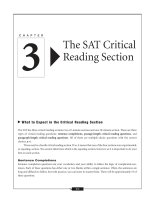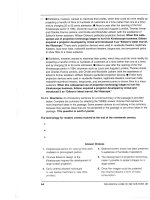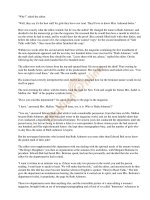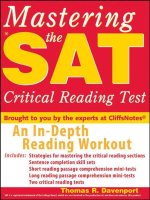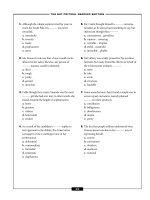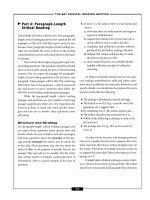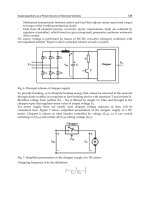The sat critical reading section 8 doc
Bạn đang xem bản rút gọn của tài liệu. Xem và tải ngay bản đầy đủ của tài liệu tại đây (92.82 KB, 6 trang )
Part 3: Paragraph-Length
Critical Reading
Out with the old and in with the new: New paragraph-
length critical reading questions have replaced the old
analogies on the SAT. And that’s good news for you,
because these paragraph-length critical reading pas-
sages are essentially the same as those in the reading
comprehension section, only much shorter and easier
to manage.
The SAT has about eight paragraph-length criti-
cal reading questions. The questions should be divided
more or less equally among the three Critical Reading
sections. You can expect the passages for paragraph-
length critical reading questions to be just that—one
paragraph. Most passages will be 100–350 words long
followed by two to five questions—a sharp contrast to
the half-dozen or more questions that follow the
400–850-word reading comprehension passages.
While the paragraph-length critical reading
passages and questions are very similar to their long
passage counterparts, there are a few important dif-
ferences to keep in mind and some specific strate-
gies you can use to answer these questions more
effectively.
Structure and Strategy
For paragraph-length critical reading passages, you
can expect fewer questions about specific facts and
details (which are easy to find in such short passages)
and more questions about the structure of the pas-
sage and the strategies the author uses to convey his
or her idea. These questions may ask you about the
order of ideas or the purpose of specific lines in the
passage. They may ask you to consider why the writer
uses certain words or includes a particular piece of
information. Here is a good example of this type of
question:
1. In lines 1–2, the author refers to a list of pros and
cons to
a. show that there are both positive and negative
aspects of utilitarianism
b. suggest that making a list of pros and cons is
not an effective way to make a decision
c. emphasize that utilitarians consider both the
good and the bad before making a decision
d. indicate that readers will learn how to make
decisions using pro/con lists
e. show readers that they are probably already
familiar with the principles of utilitarian
reasoning
So while you should continue to hone your gen-
eral reading comprehension skills and expect ques-
tions about vocabulary, the main idea, inferences, and
specific details, you should also be prepared for more
question stems like the following:
■
The passage is developed primarily through . . .
■
The author’s use of X (e.g., a specific word, list,
quotation, etc.) suggests that . . .
■
By comparing X to Y, the author implies that . . .
■
The author describes/presents/refers to X to
■
Which of the following techniques is used in the
last sentence?
■
The passage uses X (e.g., first-person point of
view) to . . .
In other words, structure and strategy questions
ask you to consider how the writer expresses his or her
ideas and what effect those writing strategies have on
the reader. What kind of examples does the writer use
to support the main idea? What is the impact of com-
paring X to Y?
It might help to think of writing as a series of deci-
sions. Writers choose their words carefully. They think
about how to punctuate and paragraph their sentences
77
–THE SAT CRITICAL READING SECTION–
5658 SAT2006[03](fin).qx 11/21/05 6:42 PM Page 77
78
Don’t Forget: General Critical Reading Strategies
Keep in mind these general critical reading strategies as you prepare for the new paragraph-length criti-
cal reading questions on the SAT.
1. Be sure to read each question carefully and understand exactly what it is asking.
2. Try to formulate an answer in your own words before looking at the answer choices. This will help
you avoid choosing tricky distracters.
3. Remember that many answer choices are distracters that (1) are true, but do not answer the ques-
tion; (2) are close to the correct answer, but wrong in some detail; or (3) use language from the pas-
sage, but do not correctly answer the question.
4. Remember that any conclusion you draw from the passage must have evidence in the passage. An
answer may be true, or you may believe it to be true, but if there is no evidence for it in the text, it
cannot be a correct answer.
5. Remember to use the process of elimination. Rule out any obviously incorrect answers to narrow
down the possible choices.
for clarity and impact. They decide which example or
comparison or image will best convey their ideas, sup-
port their argument, or arouse the desired emotion in
their readers. These critical reading questions simply
ask you to look at the decisions the writers made and
consider the impact of their choices.
On test day, you may come across a question or
two asking you to identify the specific strategy a writer
uses in a particular line or phrase. You might be asked
about the effect of a strategy, or you may need to draw
an inference based upon the writer’s use of a specific
technique.
Active Reading for
Short Passages
Because the paragraph-length critical reading passages
are so short, your active reading strategies should be
slightly different from those for the longer critical read-
ing passages.
1. Each passage is usually only one paragraph (two
at the most), so you don’t need to skim ahead
before you actually read the text. Just read
quickly, carefully, and actively the first time.
2. To save time, keep your notes to a minimum, if
you take any at all.
3. Do underline and circle key words and ideas as
you read.
4. Pay attention to strategic issues such as word
choice and structure as you read. For example,
how are the ideas in the passage organized? What
support does the author offer for his or her ideas?
Does the writer use certain words to suggest
ideas or elicit emotions from the reader?
5. After you finish the paragraph, try to sum up the
main idea in your own words. Even if there isn’t a
question about the main idea or purpose of the
passage, at least one question will probably
depend upon your understanding of the passage
as a whole. If you have trouble determining the
main idea, reread the first and last sentences—
these are the most common places to find a topic
sentence in a paragraph.
5658 SAT2006[03](fin).qx 11/21/05 6:42 PM Page 78
–LEARNINGEXPRESS ANSWER SHEET–
79
1.abcde
2.abcde
3.abcde
4.abcde
5.abcde
6.abcde
7.abcde
8.abcde
9.abcde
10.abcde
11.abcde
12.abcde
13.abcde
14.abcde
15.abcde
16.abcde
17.abcde
18.abcde
19.abcde
20.abcde
21.abcde
22.abcde
23.abcde
24.abcde
25.abcde
26.abcde
27.abcde
28.abcde
29.abcde
30.abcde
31.abcde
32.abcde
33.abcde
34.abcde
35.abcde
36.abcde
37.abcde
38.abcde
39.abcde
40.abcde
40 Practice Paragraph-Length Critical Reading Questions
The passages below are followed by several questions about their content. Read each passage carefully and answer
the questions based on what is stated or implied in the text. Use the answer sheet below to record your answers.
ANSWER SHEET
5658 SAT2006[03](fin).qx 11/21/05 6:42 PM Page 79
5658 SAT2006[03](fin).qx 11/21/05 6:42 PM Page 80
Questions 1–3 are based on the following passage about public art.
Although all art is inherently public—created in order to convey an idea or emotion to others—“public
art,” as opposed to art that is sequestered in museums and galleries, is art specifically designed for a pub-
lic arena where the art will be encountered by people in their normal day-to-day activities. Public art can
be purely ornamental or highly functional; it can be as subtle as a decorative door knob or as conspicu-
ous as the Chicago Picasso. The more obvious forms of public art include monuments, sculptures, foun-
tains, murals, and gardens. But public art also takes the form of ornamental benches or street lights,
decorative manhole covers, and mosaics on trash bins. Many city dwellers would be surprised to discover
just how much public art is really around them and how much impact public art has on their day-to-day
lives.
–THE SAT CRITICAL READING SECTION–
81
Line
(5)
1. According to the passage, public art is differenti-
ated from private art mainly by
a. the kind of ideas or emotions it aims to con-
vey to its audience
b. its accessibility
c. its perceived value
d. its importance to the city
e. the recognition that artists receive for their
work
2. The use of the word sequestered in line 2 suggests
that the author feels
a. private art is better than public art
b. private art is too isolated from the public
c. the admission fees for public art arenas pre-
vent many people from experiencing the art
d. private art is more difficult to understand than
public art
e. private art is often controversial in nature
3. The main purpose of this passage is to
a. define public art
b. make readers more aware of the public art
around them
c. argue that public art is more interesting than
private art
d. describe the functions of public art
e. provide examples of public art
5658 SAT2006[03](fin).qx 11/21/05 6:42 PM Page 81
Questions 4–8 are based on the following passage about asbestos.
Asbestos is generally made up of fiber bundles that can be broken up into long, thin fibers. We now know
from various studies that when this friable substance is released into the air and inhaled into the lungs over
a period of time, it can lead to a higher risk of lung cancer and a condition known as asbestosis. Asbesto-
sis, a thickening and scarring of the lung tissue, usually occurs when a person is exposed to high asbestos
levels over an extended period of time. Unfortunately, the symptoms do not usually appear until about
twenty years after initial exposure, making it difficult to reverse or prevent. In addition, smoking while
exposed to asbestos fibers could further increase the risk of developing lung cancer. When it comes to
asbestos exposure in the home, school, and workplace, there is no safe level; any exposure is considered
harmful and dangerous. Prior to the 1970s, asbestos use was ubiquitous—many commercial building and
home insulation products contained asbestos. In the home in particular, there are many places where
asbestos hazards might be present. Building materials that may contain asbestos include fireproofing mate-
rial (sprayed on beams), insulation material (on pipes and oil and coal furnaces), acoustical or sound-
proofing material (sprayed onto ceilings and walls), and miscellaneous materials such as asphalt, vinyl, and
cement used to make products like roofing felts, shingles, siding, wallboard, and floor tiles.
–THE SAT CRITICAL READING SECTION–
82
Line
(5)
(10)
4. In line 2, the word friable most nearly means
a. ability to freeze
b. warm or liquid
c. easily broken down
d. poisonous
e. crunchy
5. The main purpose of this passage is to
a. teach asbestos awareness in the home and
schools
b. explain the properties of asbestos
c. encourage preventative measures such as early
lung cancer screening
d. provide a list of materials that may include
asbestos
e. use scare tactics to make homeowners move to
newer houses
6. The word ubiquitous (line 9) and the list of
building materials containing asbestos (lines
11–14) serve primarily to
a. allay fears of becoming ill from asbestos
b. encourage reforms in building practice
c. describe the effects of asbestos in the home
d. urge readers to check their homes for asbestos
e. show how common asbestos is in homes built
before 1970
7. The tone of this passage is best described as
a. cautionary
b. apathetic
c. informative
d. admonitory
e. idiosyncratic
8. For whom is the author writing this passage?
a. professional contractors
b. students
c. school principals
d. health officials
e. lay persons
5658 SAT2006[03](fin).qx 11/21/05 6:42 PM Page 82
